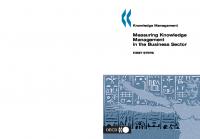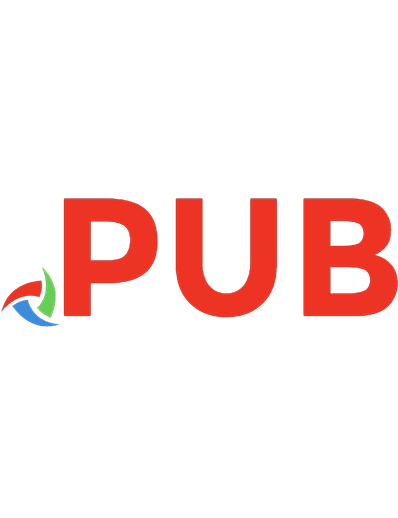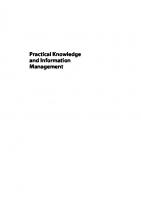Developments in Information & Knowledge Management for Business Applications: Volume 1 3030621502, 9783030621506
This book provides solutions to manage information competently in order to increase its business usage. The information/
518 21 23MB
English Pages 587 [590] Year 2021
Table of contents :
Preface
Contents
Modelling the External Economic Environment Instability Impact on the Organizational Flexibility of the Enterprise
1 Introduction
2 Paper Preparation
2.1 The Model of the Influence of Environment Instability on the Organizational Flexibility and Performance of Enterprise
2.2 Main Assumptions of the Model of the Influence of Environment Instability on the Organizational Flexibility and Performance of Enterprise
2.3 Interconnection Among the Instability of the External Economic Environment and Different Parameters of the Organizational Flexibility, the Organizational Flexibility and Performance of the Enterprise
2.4 Interconnection Among Resource and System Parameters of Organizational Flexibility
2.5 Interconnection Among Levels of Organizational Flexibility and Enterprises Performance Due to the Needs of Environment Requirements
3 Conclusions
References
Generic Reporting Tool Using Modern User Interface Design Technologies
1 Introduction
1.1 Objectives and Scope of Work
1.2 Work Layout
2 User Interface
2.1 The History of the Human–Computer Interface
2.2 Principles of Interaction Design
2.3 Summary
3 Review of Existing Solutions
3.1 IBM Cognos
3.2 JasperReports Professional
3.3 Description of Reports Provided with the Windchill System
3.4 Summary
4 Technologies Used in the Project
4.1 GWT (AJAX)
4.2 Java EE
4.3 JasperReports
4.4 DynamicJasper
4.5 Windchill (PTC)
5 Summary
6 Description of the Tool (GRT)
6.1 Functional Requirements
6.2 System Requirements not Connected to Functionality
6.3 Cases of Use
6.4 Diagrams
6.5 Architecture Description
6.6 Description of Important System Components
6.7 Summary
7 User Documentation
7.1 Description of Installation and Configuration
7.2 User’s Instructions
8 Summary
9 Summary and Conclusions of the Work
References
Use of Semantic Networks to Search for Information
1 Introduction
2 Vision of the Semantic Web
2.1 FromMemex, Through the World Wide Web to the Semantic Web
2.2 Current State of the World Wide Web
2.3 Seed of the Semantic Web
3 Technologies Used in the Semantic Web
3.1 Semantic Web Layer Cake
3.2 Unicode
3.3 URI
3.4 Structured Web Documents: XML
3.5 XML Schema
3.6 Ontologies
3.7 Taxonomies
3.8 Resource Description Framework
3.9 RDF Schema and RDFS Plus
3.10 Web Ontology Language
3.11 SPARQL
3.12 Existing Dictionaries and Ontologies
4 Existing Solutions Using the Semantic Approach
4.1 Semantic Search Engines
5 Linked Data Concept
5.1 Size of Linked Date
6 Conclusions of Theoretical Part
7 The Purpose and Scope of the Practical Part
8 Basic Assumptions
8.1 Selecting the Website that Constitutes the Data Source
8.2 Test Environment and Target Environment
8.3 Description of the Technologies Used
9 Functional Design
9.1 Searching for Resources
9.2 Presentation of Information on Resources
9.3 History of Searched Resources
9.4 History of the Presented Resources
9.5 Subpage with Information About the Project
9.6 Contact Form
10 Technical Project
10.1 Dictionaries and Ontologies Used
10.2 Database Structure
10.3 Map Attributes from Last.fm to Predicates
10.4 Hierarchy of Classes
11 Conclusions of Work
12 Summary
References
Administration Systems in Enterprises Management: Assessment and Development
1 Introduction
2 Paper Preparation
2.1 The Place of Administration Systems in Enterprises Management
2.2 Approaches to Diagnosing the Administration Systems
2.3 “Target-Means” Principle During the Administration Systems Diagnosis
2.4 Selecting the Diagnosis Parameters for Administration Systems in Enterprises
2.5 Toolset for Diagnosing the Administration Systems
2.6 Method of Diagnosing the Administration Systems as a Prerequisite for Enterprises Business Processes Reengineering
2.7 Testing the Method of Administration Systems Diagnosis
3 Conclusion
References
Simulating the Processes of Engineering Payments Establishment During the Engineering Projects Implementation at Enterprises
1 Introduction
2 Paper Preparation
2.1 Methods for Measuring the Income During the Engineering Projects Implementation
2.2 Types of Engineering Payments During the Implementation of Engineering Projects by Enterprises
2.3 Defining the Range of the Industrial Enterprise Income from the Engineering Projects Implementation
2.4 Simulating the Structure of Engineering Payments of Industrial Enterprises During the Engineering Projects Implementation
3 Conclusion
References
Corporate E-Learning as a Service
1 Introduction
2 Research Question
3 Methodology
4 Analysis of Search Terms
4.1 Keywords
4.2 Findings Per Search Term
5 Analysis of Relevant Sources Found Per Search Term
5.1 Assortment of Sources
5.2 Origin of Documents
5.3 Literature List of the 53 Relevant Papers
5.4 Analysis of Publishers
5.5 Relevance of Search Terms Based on the 53 Articles Selected
5.6 Year of Publishing
5.7 Authors
5.8 Conference Papers
6 Conclusion
References
The Impact of Electronic Services on Traditional Services
1 Introduction
2 Traditional Services
2.1 Shift in the Economy: Importance of Services
2.2 Internal Communication Tools
2.3 Service Quality
3 Electronic Services
3.1 Definition of Electronic Services
3.2 Service Quality
3.3 The Long Tail
4 Examples in the Industries
4.1 Traditional Banking Service Versus E-Banking
4.2 Traditional Shopping Service Versus Online Shopping
4.3 Netflix
4.4 Uber
5 Conclusion
References
Options to Improve the General Model of Security Management in Private Bank with GDPR Compliance
1 Introduction
1.1 Security of IT Technologies
1.2 Bank
2 Categorization of Data Processed by a Private Bank
2.1 The Flow of Information Model
3 The General Model of Safety Management in the Private Bank
4 Model of Control
5 Conclusion
References
The Process of Creating Web Applications in Ruby on Rails
1 Introduction
2 Web Applications and Tools
2.1 Web Application Development
2.2 Basic Definitions
2.3 Existing Solutions in the Field of Study
3 Used Technologies and Methods
3.1 Ruby
3.2 Ruby on Rails
3.3 Database Server
3.4 HTTP Server
3.5 Ruby Version Manager
4 Description of the Created Application
4.1 System Requirements
4.2 Design of the Developed Application
4.3 User Documentation
5 Summary
References
Revisiting State-of-the-Art Applications of the Blockchain Technology: Analysis of Unresolved Issues and Potential Development
1 Introduction
2 Theoretical and Practical Views on the Blockchain Technology and Its State-of-the Art Applications
3 Analysis of State-of-the-Art Blockchain Applications by Usage Types Deployed Across Various Domains
3.1 Blockchain-Enabled Applications Implemented in Finance
3.2 Blockchain-Enabled Applications Employed for Integrity Verification
3.3 Blockchain-Enabled Applications Adopted for Governance
3.4 Blockchain-Enabled Applications Employed for Citizenship and User Services
3.5 Blockchain-Enabled Applications Implemented in the Public Sector
3.6 Blockchain-Enabled Applications Adopted for Voting
3.7 Blockchain-Enabled Applications Employed for the Internet of Things
3.8 Blockchain-Enabled Applications Implemented in Healthcare
3.9 Blockchain-Enabled Applications Adopted for Privacy and Security
3.10 Blockchain-Enabled Applications Employed for Managing Business Processes
3.11 Blockchain-Enabled Applications Adopted for Managing Supply Chains
3.12 Blockchain-Enabled Applications Implemented in the Energy Sector
3.13 Blockchain-Enabled Applications Adopted in Education
3.14 Blockchain-Enabled Applications Employed for Data Management
3.15 Miscellaneous Blockchain-Enabled Applications in Use
4 Analysis of Unresolved Issues and Potential Development
4.1 Relevance and Suitability of the Blockchain Technology
4.2 Scalability and Latency of the Blockchain Technology
4.3 Sustainability of the Blockchain Technology
4.4 Quantum Computing; Strength and Resilience
4.5 Adoption and Interoperability of the Blockchain Technology
4.6 Data Management: Security and Privacy
4.7 Big Data and Artificial Intelligence Combined with the Blockchain Technology
5 Conclusion
References
Modeling Scenarios of Strategic Development of the Country Using Fuzzy Set Theory
1 Introduction
2 Presenting of the Main Material
3 Conclusion
References
Trends in Global Telecommunication Fraud and Its Impact on Business
1 Introduction
1.1 Goals and Objectives
2 Theoretical and Conceptual Background
2.1 Telecommunication Industry and Its Risks
2.2 Telecommunication Industry: Key Statistics
2.3 Telecommunication Industry: How Does It Work?
2.4 Types of Telecommunication Fraud
3 Modern Technologies in Use to Fight Telecom Fraud
References
Aspect Programming with the Use of AspectJ
1 Introduction
2 Aspect-Oriented Programming
2.1 Software Modularization
2.2 Limitations of Object-Oriented Programming
2.3 Aspect-Oriented Programming (AOP)
2.4 Summary
3 AspectJ Language Presentation
3.1 Circumstances of the Emergence and Development of the AspectJ Language
3.2 Key Concepts of Language
3.3 Weaving Process
3.4 Summary
4 Overview of the AOP Application
4.1 The Issue of System Design Using AOP
4.2 Design Patterns Using AOP
4.3 Overview of the Application of Aspect-Oriented Programming
4.4 Summary
5 The Practical Part—The “Advertising Service” Application
5.1 Application Architecture and Used Technologies
5.2 Requirements for the Created Application
5.3 Description of the Implementation
5.4 Summary
6 Summary
References
Use of RFID Technology in Retail Supply Chain
1 Introduction
2 RFID in General
2.1 RFID Definition
2.2 History of RFID Technology
2.3 RFID Architecture
2.4 Business Aspect of RFID
3 Bar Code
3.1 Barcode Symbology
3.2 Barcode Through History
3.3 Linear Bar Code
3.4 Business Aspect of Bar Code
4 RFID Versus Bar Code
4.1 RFID Technology Analysis
5 RFID in a Retail Supply Chain
5.1 Retail Supply Chain
5.2 RFID in SCM
5.3 Software in Retail
5.4 RFID in Practice in Retail
5.5 Unification/Consolidation
6 Further Development
7 Conclusion
References

![Developments in Information & Knowledge Management for Business Applications: Volume 1 (Studies in Systems, Decision and Control Book 330) [1st ed. 2021]
9783030621513, 9783030621506, 3030621510](https://dokumen.pub/img/200x200/developments-in-information-amp-knowledge-management-for-business-applications-volume-1-studies-in-systems-decision-and-control-book-330-1st-ed-2021-9783030621513-9783030621506-3030621510.jpg)




![Machine Learning for Asset Management: New Developments and Financial Applications [1 ed.]
1786305445, 9781786305442](https://dokumen.pub/img/200x200/machine-learning-for-asset-management-new-developments-and-financial-applications-1nbsped-1786305445-9781786305442.jpg)


![Supply Chain Management For Dummies (For Dummies (Business & Personal Finance)) [1 ed.]
1119410193, 9781119410195](https://dokumen.pub/img/200x200/supply-chain-management-for-dummies-for-dummies-business-amp-personal-finance-1nbsped-1119410193-9781119410195.jpg)
